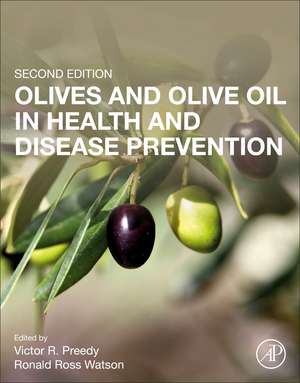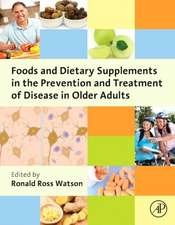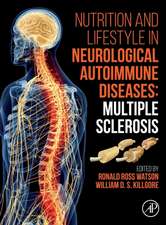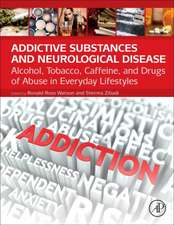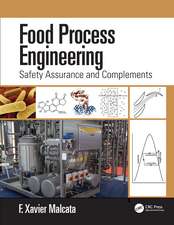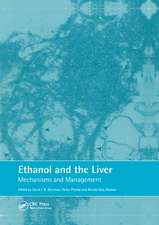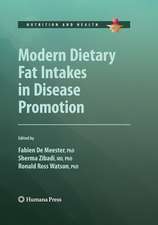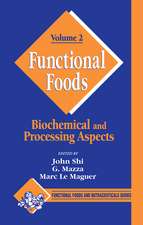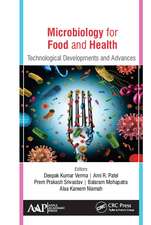Olives and Olive Oil in Health and Disease Prevention
Editat de Victor R. Preedy, Ronald Ross Watsonen Limba Engleză Paperback – 3 dec 2020
- Continues the tradition of exploring olives and olive oil from general aspects down to a detailed level of important micro-and micronutrients
- Explains how olive oil compares to other oils
- Details the many implications for human health and disease, including metabolic health, cardiovascular health and effects on tissue and body systems
Preț: 1019.17 lei
Preț vechi: 1306.91 lei
-22% Nou
Puncte Express: 1529
Preț estimativ în valută:
195.06€ • 202.85$ • 163.23£
195.06€ • 202.85$ • 163.23£
Carte tipărită la comandă
Livrare economică 08-22 martie
Preluare comenzi: 021 569.72.76
Specificații
ISBN-13: 9780128195284
ISBN-10: 0128195282
Pagini: 746
Ilustrații: Approx. 240 illustrations
Dimensiuni: 216 x 276 mm
Greutate: 1.7 kg
Ediția:2
Editura: ELSEVIER SCIENCE
ISBN-10: 0128195282
Pagini: 746
Ilustrații: Approx. 240 illustrations
Dimensiuni: 216 x 276 mm
Greutate: 1.7 kg
Ediția:2
Editura: ELSEVIER SCIENCE
Cuprins
PART 1 General Aspects of Olives and Olive Oil
1.1 The plant, production, olives and olive oil and their detailed characterization
1. Table olives: types and trade preparations; 2. Naturally processed table olives, their preservation and uses; 3. Olive tree genetics, genomics and transcriptomics for the olive oil quality improvement; 4. The chemical composition of Italian virgin olive oils
1.2 Components of Olives and Olive Plant Product and Uses
5. Bioactive ingredients in olive leaves; 6. Detection of adulterations of extra virgin olive oil by means of infrared thermography; 7. Influence of the distribution chain on the quality of extra virgin olive oils; 8. Spectroscopy to evaluate the quality control of extra virgin olive oils; 9. Chemical composition of fermented green olives; 10. Polyphenols in Olive Oil: The importance of Phenolic Compounds in the Chemical Composition of Olive Oil; 11. Polyphenol oxidase and oleuropein in olives and their changes during olive ripening
1.3 Stability, Microbes, Contaminants and Adverse Components and Processes
12. Degradation of phenolic compounds found in olive products by Lactobacillus plantarum strains; 13. Microbial colonization of naturally fermented olives
PART 2 Nutritional, Pharmacological and Metabolic Properties of Olives and Olive Oil
2.1 General Nutritional and Health Aspects
14. Overview of Olive oil in vascular dysfunction; 15. Olive in Traditional Persian Medicine: An Overview; 16. The bioavailability of olive oil phenolic compounds and their bioactive effects in humans; 17. Mediterranean Diet and role of olive oil; 18. Probiotics from Fermented Olives; 19. Olive oil-contained phenolic compounds protect cells against H2O2-induced damage and modulate redox signaling by chelating intracellular labile iron; 20. Synaptosomes as a model to study fish- and olive-oil effect as neuroprotectors; 21. Olive oil and postprandial energy metabolism: implications for weight control; 22. Effect of Olive oil on Metabolic Syndrome
2.2 Cardiovascular
23. Olive and olive oil: a one stop herbal solution for the prophylaxis and management of cardiovascular disorders; 24. Extra-virgin olive oils storage: effect on constituents of biological significance
2.3 Oxidative Stress
25. Antioxidants in olive oil phenolics: a focus on myoblasts; 26. Antioxidant activity in olive oils
2.4 Cancer and Immunology
27. Olives and olive oil compounds active against pathogenic microorganisms; 28. Olive oil in the prevention of breast and colon carcinogenesis; 29. The effects of olive oil and other dietary fats on redox status on breast cancer; 30. Olive Pollen Allergens: an insight into clinical, diagnostic and therapeutic concepts of allergy; 31. Cancer preventive role of olives and olive oil via modulation of apoptosis and NF-κB activation; 32. Immune system and olive oil
2.5 Other Effects, Uses and Diseases
33. Effect of olive oil on the skin; 34. Extra virgin olive oil, cognition and brain health; 35. The Foundation for the Use of Olive Oil in Skin Care and Botanical Cosmeceuticals; 36. Olive oil and male fertility; 37. Revealing the Molecular Mechanism of Olea Europaea L. in Treatment of Cataract; 38. Olive leaf, DNA damage and chelation therapy; 39. Olive polyphenols and chronic alcohol protection; 40. Olive oil diet and amyloidosis: focus on Alzheimer’s disease; 41. Olive biophenols benefits and challenges: A perspective; 42. Treatment and valorization of olive mill wastewater
PART 3 Specific Components of Olive Oil and Their Effects on Tissue and Body Systems
3.1 Tyrosol and Hydroxytyrosol
43. Cancer chemopreventive activity of maslinic acid, a pentacyclic triterpene from olives and olive oil; 44. Hydroxytyrosol, olive oil and use in aging; 45. Hydroxytyrosol and hydroxytyrosyl fatty esters: occurrence and anti-inflammatory properties; 46. Influence of olive oil on pancreatic, biliary and gastric secretion. Role of gastrointestinal peptides; 47. Effects of virgin olive oil on fatty acid composition of pancreatic cells membranes: modulation of acinar cell function and signalling, and cell injury; 48. Hydroxytyrosol: features and impact on pancreatitis; 49. The Effects of extra-virgin olive oil minority compounds hydroxytyrosol and oleuropein on glioma
3.2 Oleuropein
50. The usage of oleuropein on myocardium; 51. Oleuropein and skin cancer; 52. Oleuropein, olive and insulin resistance
3.3 Oleic Acid
53. Oleic acid, the main component of olive oil on postprandial metabolic processes; 54. Oleic acid and olive oil polyphenols down-regulate fatty acid and cholesterol synthesis in brain and liver cells
3.4 Oleocanthal
55. Olive Oil Oleocanthal and Estrogen Receptor Expression; 56. Neuroprotective Effects of Oleocanthal in Neurological Disorders; 57. S-(-)-Oleocanthal as a c-Met receptor tyrosine kinase inhibitor and its application to synergize targeted therapies and prevent breast cancer recurrence; 58. Phenolic Compounds in Olive Oil Mill Wastewater (2nd Edition)
PART 4 Online Resources and other Recommended Material
Online Resources and other Recommended Material
1.1 The plant, production, olives and olive oil and their detailed characterization
1. Table olives: types and trade preparations; 2. Naturally processed table olives, their preservation and uses; 3. Olive tree genetics, genomics and transcriptomics for the olive oil quality improvement; 4. The chemical composition of Italian virgin olive oils
1.2 Components of Olives and Olive Plant Product and Uses
5. Bioactive ingredients in olive leaves; 6. Detection of adulterations of extra virgin olive oil by means of infrared thermography; 7. Influence of the distribution chain on the quality of extra virgin olive oils; 8. Spectroscopy to evaluate the quality control of extra virgin olive oils; 9. Chemical composition of fermented green olives; 10. Polyphenols in Olive Oil: The importance of Phenolic Compounds in the Chemical Composition of Olive Oil; 11. Polyphenol oxidase and oleuropein in olives and their changes during olive ripening
1.3 Stability, Microbes, Contaminants and Adverse Components and Processes
12. Degradation of phenolic compounds found in olive products by Lactobacillus plantarum strains; 13. Microbial colonization of naturally fermented olives
PART 2 Nutritional, Pharmacological and Metabolic Properties of Olives and Olive Oil
2.1 General Nutritional and Health Aspects
14. Overview of Olive oil in vascular dysfunction; 15. Olive in Traditional Persian Medicine: An Overview; 16. The bioavailability of olive oil phenolic compounds and their bioactive effects in humans; 17. Mediterranean Diet and role of olive oil; 18. Probiotics from Fermented Olives; 19. Olive oil-contained phenolic compounds protect cells against H2O2-induced damage and modulate redox signaling by chelating intracellular labile iron; 20. Synaptosomes as a model to study fish- and olive-oil effect as neuroprotectors; 21. Olive oil and postprandial energy metabolism: implications for weight control; 22. Effect of Olive oil on Metabolic Syndrome
2.2 Cardiovascular
23. Olive and olive oil: a one stop herbal solution for the prophylaxis and management of cardiovascular disorders; 24. Extra-virgin olive oils storage: effect on constituents of biological significance
2.3 Oxidative Stress
25. Antioxidants in olive oil phenolics: a focus on myoblasts; 26. Antioxidant activity in olive oils
2.4 Cancer and Immunology
27. Olives and olive oil compounds active against pathogenic microorganisms; 28. Olive oil in the prevention of breast and colon carcinogenesis; 29. The effects of olive oil and other dietary fats on redox status on breast cancer; 30. Olive Pollen Allergens: an insight into clinical, diagnostic and therapeutic concepts of allergy; 31. Cancer preventive role of olives and olive oil via modulation of apoptosis and NF-κB activation; 32. Immune system and olive oil
2.5 Other Effects, Uses and Diseases
33. Effect of olive oil on the skin; 34. Extra virgin olive oil, cognition and brain health; 35. The Foundation for the Use of Olive Oil in Skin Care and Botanical Cosmeceuticals; 36. Olive oil and male fertility; 37. Revealing the Molecular Mechanism of Olea Europaea L. in Treatment of Cataract; 38. Olive leaf, DNA damage and chelation therapy; 39. Olive polyphenols and chronic alcohol protection; 40. Olive oil diet and amyloidosis: focus on Alzheimer’s disease; 41. Olive biophenols benefits and challenges: A perspective; 42. Treatment and valorization of olive mill wastewater
PART 3 Specific Components of Olive Oil and Their Effects on Tissue and Body Systems
3.1 Tyrosol and Hydroxytyrosol
43. Cancer chemopreventive activity of maslinic acid, a pentacyclic triterpene from olives and olive oil; 44. Hydroxytyrosol, olive oil and use in aging; 45. Hydroxytyrosol and hydroxytyrosyl fatty esters: occurrence and anti-inflammatory properties; 46. Influence of olive oil on pancreatic, biliary and gastric secretion. Role of gastrointestinal peptides; 47. Effects of virgin olive oil on fatty acid composition of pancreatic cells membranes: modulation of acinar cell function and signalling, and cell injury; 48. Hydroxytyrosol: features and impact on pancreatitis; 49. The Effects of extra-virgin olive oil minority compounds hydroxytyrosol and oleuropein on glioma
3.2 Oleuropein
50. The usage of oleuropein on myocardium; 51. Oleuropein and skin cancer; 52. Oleuropein, olive and insulin resistance
3.3 Oleic Acid
53. Oleic acid, the main component of olive oil on postprandial metabolic processes; 54. Oleic acid and olive oil polyphenols down-regulate fatty acid and cholesterol synthesis in brain and liver cells
3.4 Oleocanthal
55. Olive Oil Oleocanthal and Estrogen Receptor Expression; 56. Neuroprotective Effects of Oleocanthal in Neurological Disorders; 57. S-(-)-Oleocanthal as a c-Met receptor tyrosine kinase inhibitor and its application to synergize targeted therapies and prevent breast cancer recurrence; 58. Phenolic Compounds in Olive Oil Mill Wastewater (2nd Edition)
PART 4 Online Resources and other Recommended Material
Online Resources and other Recommended Material
